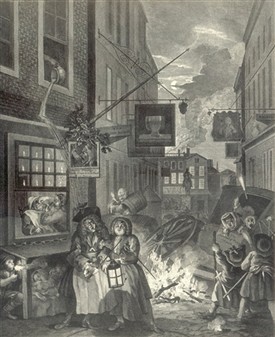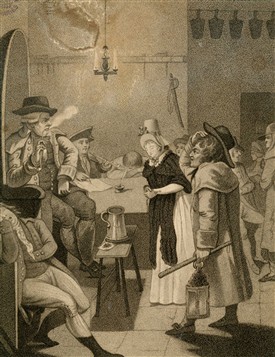Centuries of glory, shame

Charing cross on the borders of Covent Garden 1738
Westminster City Archives

Interior view of covent garden watchhouse a prostitute is being shown to a man smoking an opium pipe c1875
Westminster City Archives

Nell Gwynne c1680
Westminster City Archives
From the Piazza, northwards and eastwards, spread supporting trades for the market and for the resident gentry. Shops sold everything from fabric to birds. Haphazard development led to crowded alleyways and increasingly insanitary conditions. By the early 18th century the wealthy residents were moving to bright new squares in St. James’s and Mayfair. They made way for the writers, artists and theatre folk who made Covent Garden famous for the next 200 years.
The literary world gathered in the taverns, and in the coffee houses that multiplied here from the early 1700s. More theatres would be built in Covent Garden than in the whole of the rest of London, the first being Drury Lane in 1663. Brothels catered for every class of society, and there were 4 Turkish ‘hummum’ bath houses. Few of the gentry remained living in the area, but it became their playground.
Craftsmen and manufacturing premises proliferated, too, including tailors, goldsmiths, barrow-makers, and dozens of coach builders. The Woodyard brewery was founded on Shelton Street in 1740; by the late 19th century it was one of London’s largest under the Combes, absorbing nearby buildings and covering 4 acres. Comyn Ching’s ironworks was established in the early 1700’s and expanded across a block of Seven Dials. The area became a centre of the publishing trade, with numerous small print shops as well as Odhams Press which was established near the Strand in 1847 and moved to Long Acre in 1905.
Meanwhile, new buildings were completed for the market in the 1830s. Designed by Charles Fowler, they still stand today. Cubitt’s iron and glass roofs were added in 1875 and 1889. Over 300 years, as the market’s requirements grew, the Bedford estate dedicated more space for its use. And as it grew, so did the population that supported it.
Amid the glamour and busy industry, many of the mansions and town houses turned into densely populated tenements. They fell into disrepair, and in Seven Dials house facades even collapsed with tenants inside. Immigrants came from Ireland and Europe, pushing the population of wider Covent Garden into the tens of thousands. Subletting is not a modern issue: in the 1700s overcrowding grew as the landowners’ tenants packed several subtenant families into each house, and sometimes into each room.
Hogarth drew scenes of desperate squalor in the violent ‘rookeries’ of St. Giles in the 1750s. Henry and John Fielding established London’s first, small police force from Bow Street magistrates’ court in 1749 to tackle crime, and the Seven Dials column was removed in 1773 in an attempt to stop gangs such as The London Mob gathering.